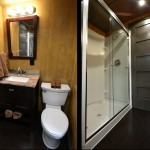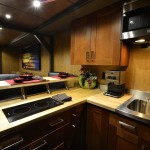 We wrote about this survival pod designed to withstand any type of disaster back in June 2016 when we first heard about it. Now, we heard on a radio program on NPR that the first customer in the United States has bought one and it is now deployed in Ocean Park, Washington.
We wrote about this survival pod designed to withstand any type of disaster back in June 2016 when we first heard about it. Now, we heard on a radio program on NPR that the first customer in the United States has bought one and it is now deployed in Ocean Park, Washington.
Jeanne Johnson lives in Ocean Park, which is just north of the Oregon border. It is prime tsunami country. Some parts of the Oregon-Washington coast, like the sandy, flat peninsula where Johnson lives, offers no high ground protection. Sometimes, there are bluffs right behind the coastal zone. So if you’re walking along the beach and happen to be in one of these spots when a tsunami hits, there might not be time to get out and up to high ground.
Johnson’s survival pod is sold by Mukilteo, Washington-based Survival Capsule LLC. Her pod is designed for 2 people, while other models are designed for 4 people. The company has sold 8 other pods to people in Japan. The pods are made of aircraft aluminum and the 2-person pod is about 4 1/2 feet in diameter. Two tiny windows like portholes would allow you to see out around you while you are strapped in. It comes with air tanks and drinking water bladders. A ceramic heat shield on the inside makes it suitable to protect users from other types of disasters too, such as fires.
Yes, it sounds claustrophobic! But, says Johnson, the alternative is not surviving because you have nowhere to go and you drown, or not surviving because you are caught in the panic of crowds all trying to get away. In the pod, you might be bobbing around for a while and having “the ride of your life,” but at least you would be protected right where you are. She keeps her pod in her garage.
How much are you willing to pay for this protection? The 2-person pod starts at $13,500 and the 4-person pod starts at $17,500. Other pods are available to hold 6, 8 and 10 people. If you live in a place prone to wildfire or tsunamis, or earthquakes, or tornadoes, and you have a family that you don’t believe you can evacuate in time, this could be an excellent insurance policy.
Photo of Jeanne Johnson from kuow.org by Tom Banse/Northwest News Network
Photo of pod from survival-capsule.com





